The second life of wired radio
When sorting out my grandmother's things, I came across a wired radio ( subscriber loudspeaker ) that served faithfully for about 30 years. Of course, it is impossible to call it an outstanding creation of the Soviet industrial design, but it is also a pity to throw it out.

On the other hand, where to apply it? There is no subscriber radio station in my apartment, and there is no particular desire to listen to the broadcast of the national radio. That would be to listen to what you want and kind of like on the radio ... And, personally, why not? And then I had the idea to make a regular speaker out of a subscriber loudspeaker! Well, i.e. ordinary monokolonku connected to the sound source through the amplifier.
To determine the model of the device, it was necessary to search by appearance with complete brute force, since Neither the model name, nor the manufacturer on the case did not appear. Fortunately, the search was short - I got Donbass subscriber loudspeaker .
')

In my case, however, it is black and yellow, without a handle, without a back wall, without a plug and with a twisted wire.
The essence of the upgrade is to integrate the amplifier into the loudspeaker body and connect any sound source to the input. With the amplifier, the question was resolved simply enough: to drop it out of unnecessaryChinese Taiwanese speakers.
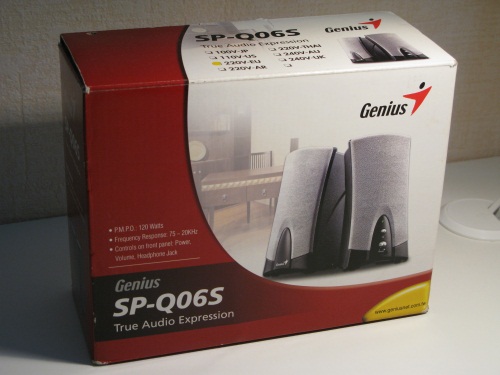
It should be noted that the use of an amplifier from Taiwanese speakers is not the best option in terms of sound quality, but the easiest and cheapest (subject to the availability of such speakers).
The main issue of modernization was the source of sound. You can connect anything to an input: a portable radio, a player, a phone, a laptop. At the same time, I did not want to overload the device functionally, but on the contrary - to make it as simple and convenient to use as possible. A good option would be to use the audio output of the AirPort Express, but it is already in use, and did not want to buy another router. The best option was found unexpectedly.
It was decided to hang the loudspeaker in the kitchen on the wall where it was originally planned to hang the TV. Under the TV, the TV and TV sockets were removed, and the TV cable from the socket goes to another room to a single place where the cables for the TV and modem are switched.
And what if you let the sound through the coaxial cable from the room into the kitchen? From the room I connect everything I want, and at the output I just amplify the sound. It is clear that the coax to oxygen-free copper is far away, but I'm not going to listen to hi-fi over a loudspeaker.
Well, let's get started. Of the three parts in the loudspeaker package: the speaker, the variable resistor and the transformer, we leave only the speaker. More precisely, at first it is necessary to remove all the details, wash away the bloom of stormy youth from the body and then insert back just the necessary one. I want to warn you right away : the loudspeaker speaker reproduces sound in the range of approximately 160-6300 Hz , so if you are going to listen to your favorite music through such a speaker, then it will sound at least not quite authentic.
We disassemble the Taiwanese speakers: from the one with the volume control, we withdraw the board and the transformer. In my case, the speaker in the column was not soldered, but connected through the connector. We solder the wires together with the connector from the din of the gangs and solder to the loudspeaker dynamics. The transformer from the speakers, too, with a connector, and therefore almost without any problems, it replaced the former one in the loudspeaker housing. Go to the board.
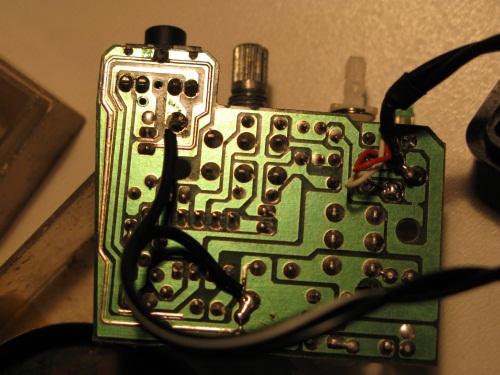
We unsolder the second column (wires to the left), and instead of wires from the jack (to the right) we solder the original wire from the subscriber unit. The main thing here is to find which channel goes to the speaker and get soldered to it. The second channel can be grounded. Next, solder a variable resistor, and in its place solder three wiring (again from the side of the channel going to the speaker).
These wires are soldered to a variable resistor of the same rating, but with a switch. And the variable resistor itself is fixed in place of the former in the case. The switch will act as a button to turn on the gain circuit. As a result, when you turn the knob, the amplifier will turn on first and then adjust the volume. Interestingly, the power button on the amplifier in the columns that I used is after the transformer. Those. when these speakers are connected to the network, regardless of whether the circuit itself is enabled or not, they consume their two watts. Actually, that's why I put the switch not in place of the button, but in front of the transformer.
I attached the board and the power connector with silicone glue to the case, and from the old Soviet pens I chose the most suitable one. As a result, the loudspeaker looks like from the inside:
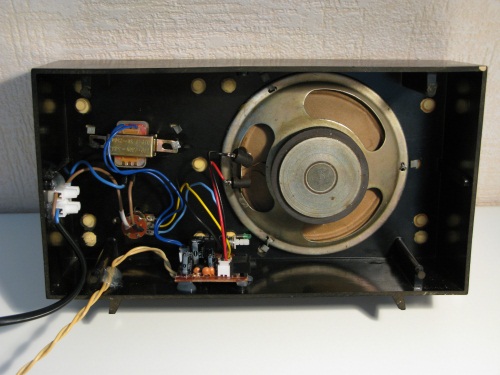
And so - outside:
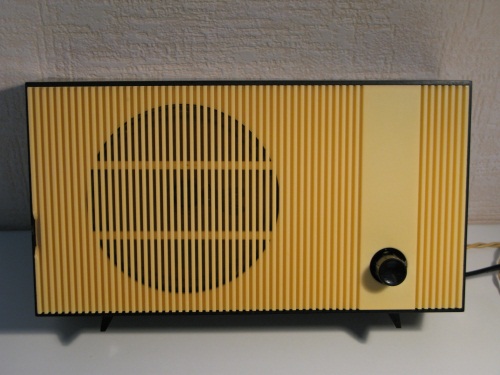
Let's not forget about the sockets: we change the standard white for more suitable black and yellow in color:
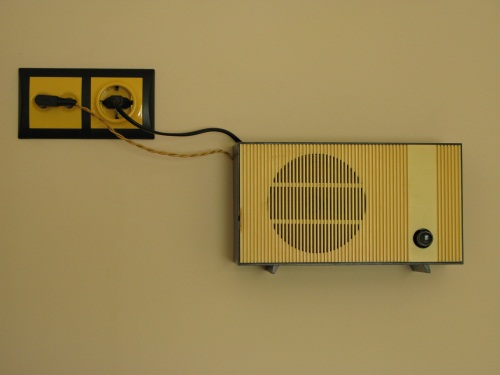
Switching point (adapter: coax - mono jack, extension cable: jack-mother - jack-father):

In operation, thesubscriber's usual loudspeaker behaves well - it regularly reproduces the sound supplied to the input, coloring it with the effect of a wired radio. Automatically, the sound source in the form of a laptop has become a director’s console, since When a microphone is connected, it is possible to broadcast from the room to the kitchen: send greetings, set your favorite music, and also communicate with radio listeners. Of the minuses can be noted perhaps that the characteristic background of the amplifier from cheap Taiwanese speakers.
For the director's console:
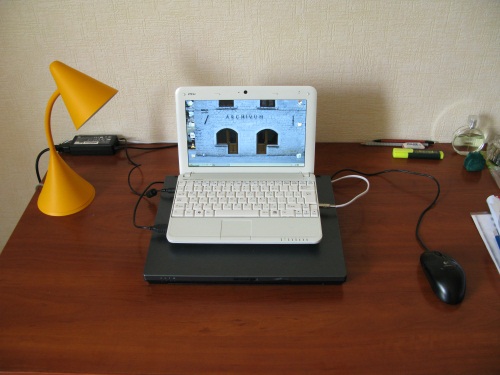
Connected subscriber:

If suddenly at home / on the balconies / at the cottage / at the grandmother / at the grandfather you find an unused subscriber loudspeaker, then remember: it can be given a second life. Wired radio is not dead - it lives in another room!

On the other hand, where to apply it? There is no subscriber radio station in my apartment, and there is no particular desire to listen to the broadcast of the national radio. That would be to listen to what you want and kind of like on the radio ... And, personally, why not? And then I had the idea to make a regular speaker out of a subscriber loudspeaker! Well, i.e. ordinary monokolonku connected to the sound source through the amplifier.
What did I get?
To determine the model of the device, it was necessary to search by appearance with complete brute force, since Neither the model name, nor the manufacturer on the case did not appear. Fortunately, the search was short - I got Donbass subscriber loudspeaker .
')

In my case, however, it is black and yellow, without a handle, without a back wall, without a plug and with a twisted wire.
Modernization plan
The essence of the upgrade is to integrate the amplifier into the loudspeaker body and connect any sound source to the input. With the amplifier, the question was resolved simply enough: to drop it out of unnecessary

It should be noted that the use of an amplifier from Taiwanese speakers is not the best option in terms of sound quality, but the easiest and cheapest (subject to the availability of such speakers).
The main issue of modernization was the source of sound. You can connect anything to an input: a portable radio, a player, a phone, a laptop. At the same time, I did not want to overload the device functionally, but on the contrary - to make it as simple and convenient to use as possible. A good option would be to use the audio output of the AirPort Express, but it is already in use, and did not want to buy another router. The best option was found unexpectedly.
It was decided to hang the loudspeaker in the kitchen on the wall where it was originally planned to hang the TV. Under the TV, the TV and TV sockets were removed, and the TV cable from the socket goes to another room to a single place where the cables for the TV and modem are switched.
And what if you let the sound through the coaxial cable from the room into the kitchen? From the room I connect everything I want, and at the output I just amplify the sound. It is clear that the coax to oxygen-free copper is far away, but I'm not going to listen to hi-fi over a loudspeaker.
Modernization
Well, let's get started. Of the three parts in the loudspeaker package: the speaker, the variable resistor and the transformer, we leave only the speaker. More precisely, at first it is necessary to remove all the details, wash away the bloom of stormy youth from the body and then insert back just the necessary one. I want to warn you right away : the loudspeaker speaker reproduces sound in the range of approximately 160-6300 Hz , so if you are going to listen to your favorite music through such a speaker, then it will sound at least not quite authentic.
We disassemble the Taiwanese speakers: from the one with the volume control, we withdraw the board and the transformer. In my case, the speaker in the column was not soldered, but connected through the connector. We solder the wires together with the connector from the din of the gangs and solder to the loudspeaker dynamics. The transformer from the speakers, too, with a connector, and therefore almost without any problems, it replaced the former one in the loudspeaker housing. Go to the board.

We unsolder the second column (wires to the left), and instead of wires from the jack (to the right) we solder the original wire from the subscriber unit. The main thing here is to find which channel goes to the speaker and get soldered to it. The second channel can be grounded. Next, solder a variable resistor, and in its place solder three wiring (again from the side of the channel going to the speaker).
These wires are soldered to a variable resistor of the same rating, but with a switch. And the variable resistor itself is fixed in place of the former in the case. The switch will act as a button to turn on the gain circuit. As a result, when you turn the knob, the amplifier will turn on first and then adjust the volume. Interestingly, the power button on the amplifier in the columns that I used is after the transformer. Those. when these speakers are connected to the network, regardless of whether the circuit itself is enabled or not, they consume their two watts. Actually, that's why I put the switch not in place of the button, but in front of the transformer.
I attached the board and the power connector with silicone glue to the case, and from the old Soviet pens I chose the most suitable one. As a result, the loudspeaker looks like from the inside:

And so - outside:

Let's not forget about the sockets: we change the standard white for more suitable black and yellow in color:

Switching point (adapter: coax - mono jack, extension cable: jack-mother - jack-father):

In work
In operation, the
For the director's console:

Connected subscriber:

findings
If suddenly at home / on the balconies / at the cottage / at the grandmother / at the grandfather you find an unused subscriber loudspeaker, then remember: it can be given a second life. Wired radio is not dead - it lives in another room!
Source: https://habr.com/ru/post/92478/
All Articles